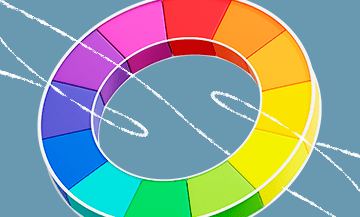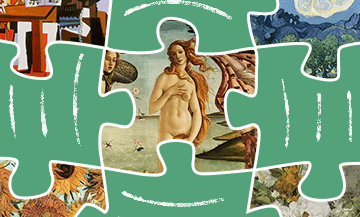How to paint oil paintings: paints, brushes, palette knife
What does a beginning artist need?
Do you think it’s worth buying all the painting materials right away, or can you start with just the basics: one brush, a couple of tubes of paint, and a canvas? Let’s think it over together.
Of course, having everything you need at hand will bring true pleasure. Being an artist and having the freedom to bring your ideas to life without any limitations is indeed an inspiring feeling. However, experience suggests that such luxury is not always available, except perhaps for art supply store owners.
On the other hand, beginners often claim that it’s wiser to start with a limited but carefully selected set of tools. I agree with them. This not only saves your money but also helps you develop your painting skills gradually.
The choice of art materials should depend on your preferences and the painting style you are working with.Here is a standard set of what every beginner artist might need:
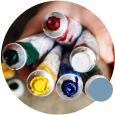
Oil paints;

Brushes;

Canvases;

Oil paint thinner;

Pencil and kneaded eraser;

Palette for oil paints;

Canvas primer;

Palette knife;

Easel;

Palette knife.
All these materials will make your work easier. And most importantly: when you have everything you need at hand, you won’t want to postpone painting. On the contrary, it’s a wonderful motivation to finally pick up your brushes!
Now let’s look at each item on this list in more detail. I hope that after reading this article, you’ll easily determine which components are necessary for your initial oil painting set and which ones can be postponed for later.
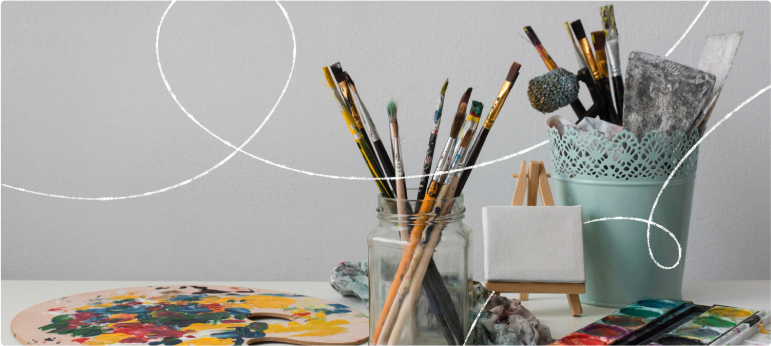
Oil paints
Each tube of oil paint contains a wealth of shades, creating a palette comparable to nature itself. From the delicate hues of a sunset to the deep shadows of night—oil paints seem to capture the emotions of time and moment on the canvas.
Why, you might ask, does an artist need such paints?
This material allows the artist to play with texture and volume, creating three-dimensional worlds on the canvas from colorful harmonies. They enable the artist to express the harmony of light and shadow, immersing the viewer in a whirl of emotions and experiences.
Oil paints dry slowly, giving the artist invaluable time for detailed work and for bringing their vision to life on the canvas.
However, perhaps the most important aspect of oil paints is their ability to create works that penetrate deep into the viewer’s soul. The feelings, emotions, and ideas imprinted on the canvas remain with them forever, evoking a magical sense of connection with the creator.
Why does the artist strive for oil paints? Because they offer the opportunity to unfold, to tangibly feel the texture and richness of color.
Before buying large tubes of paint, test different colors on small samples or on a color palette. This way, you will better understand how the colors look in real conditions and how they blend with each other.
Art does not always find its embodiment in diplomas and academic degrees. Perhaps a true artist is someone who sees beauty in every detail of life and knows how to share it with the world?
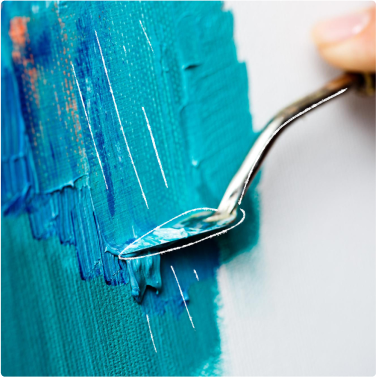

Painting Brushes
Brushes are an extension of the artist’s hand. With them, you can render details with microscopic precision or, conversely, dive into expressive strokes, capturing thrilling moments intuitively.
How to choose brushes? For example, if your goal is to paint a large abstract piece measuring 60×90 cm, you will need wide brushes. They provide convenience when covering the entire canvas and allow you to express your creative concept in all its grandeur.
If your painting requires a multitude of fine details, demanding careful and detailed rendering, small and thin brushes will be indispensable.
Each brush hides the potential to bring the boldest ideas and fantasies to life. From fine lines to broad strokes—the variety of brush shapes and sizes gives the artist complete control over their creation. It’s like a palette of magic, where each brush is the key to a special spell on the canvas.
| Choose brushes of different sizes right away. This will expand your possibilities and diversify your creative work. Make sure the brush feels comfortable in your hand and is easy to work with. Don’t forget to check its flexibility and resilience. |
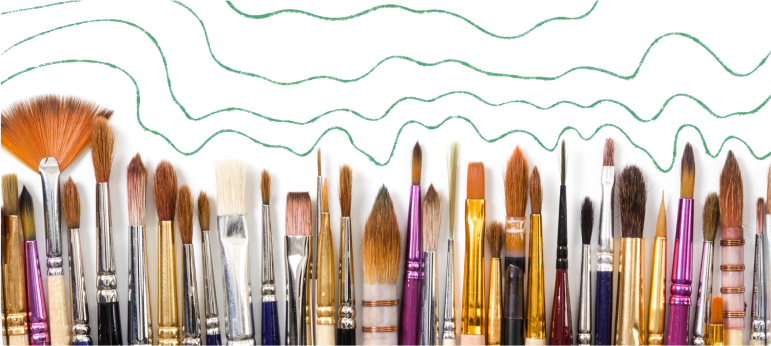
Canvases
When choosing a canvas for your debut oil painting, a beginner artist faces a host of questions. Which option to choose: stretcher frame or cardboard? To prime it yourself or take a ready-made one? Which primer to use? And what if the canvas starts to sag under the paint?
Yes, you will definitely encounter uncomfortable questions that you might be hesitant to ask more experienced artists. But don’t be afraid. You are just learning, and I assure you, it’s not always easy for beginners to understand all the nuances of painting.
First, decide on the canvas backing: stretcher frame or cardboard? A stretcher frame provides structure and strength, like a well-trodden road. On the other hand, cardboard can add lightness and an experimental nature, like an enticing path in a forest of ideas.
Next, decide whether to prime the canvas yourself or to buy one that is already primed. Primer is like the foundation for a house, and the type you choose will determine how the paints interact with the surface.


A ready-made primer can simplify your creative process, but creating your own primer is a kind of ritual where you directly influence the nature of your future work.
And don’t forget about the weight of the canvas, as it is like choosing between the lightness of a bird in flight and the sturdiness of an oak. A thin canvas will give you the lightness of movement, while a thick one will provide confidence in each brushstroke.
Trust your intuition, be open to discoveries, and don’t hesitate to explore the paths of art.
Before purchasing, carefully inspect the canvas for defects such as holes, creases, or irregularities.
Thinner for oil paints
Thinner dilutes paint, while solvent dissolves the paint layer. For painting, turpentine is one of the most versatile materials, ideal for creating thin layers in oil painting.
Turpentine effectively thins paints and varnishes, maintaining its transparency and virtually not yellowing over time. However, turpentine has a specific smell, and if you are sensitive to odors, you might want to consider other options for oil paint thinners.
For example, “triple” (also known as “triple turpentine”). This thinner is unique due to its composition of three key components: damar varnish, linseed oil, and turpentine. Triple is available as a ready-made product, but you can also mix it at home.
Its main advantages are that it simultaneously acts as a protective layer for the painting, similar to varnish, improves paint properties due to the linseed oil, and, of course, has the characteristic smell of turpentine.
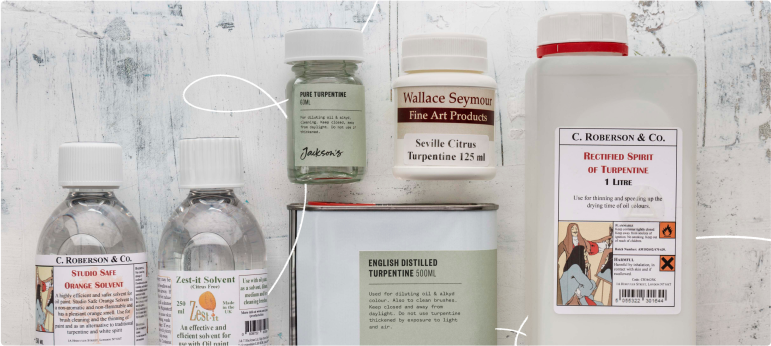
Simple pencil + eraser
Indispensable companions for artists are the pencil and eraser; they are useful at any stage, even during the sketching phase.
Graphite pencils are categorized by their degree of softness and hardness: a soft pencil is marked with the letter B, a hard pencil with the letter H, and a pencil of medium softness is marked HB (this is the one I recommend for beginners).
A flexible kneaded eraser cleans the surface from pencil marks and even corrects small details. Unlike ordinary erasers, a kneaded eraser provides gentle and precise erasing without damaging the paper.
Be sure to add a pencil and eraser to your shopping list — you can’t go without them in drawing.
Palette for oil paints
A palette for an artist is a magical arsenal that unveils an endless ocean of creative possibilities. So why is such an indispensable tool essential for an artist?
Firstly, a palette is a sort of color “dictionary,” allowing the artist to play and experiment with an endless variety of shades — from pastel palettes to vibrant and contrasting combinations.
Secondly, a palette is an organizer of creative chaos. It helps the artist structure and organize colors, providing the ability to quickly find the necessary shades during the creative process.
Palettes can be made of either plastic or wood. To simplify the cleaning process and make it easier to remove paint from the palette, it is recommended to cover it with plastic wrap beforehand.


Priming
Primer creates the ideal foundation for your work. It provides stability and durability, protecting the canvas from negative environmental factors such as moisture or light.
It can affect the way colors are perceived. For example, white primer will enhance the brightness and richness of colors, while gray will create a special deep lighting effect.
Primer is especially important when working with oil and acrylic paints, as it maintains the longevity and vibrancy of the paints.
I recommend purchasing pre-primed canvases. However, if you decide to apply the primer yourself, choose a special artist’s primer.
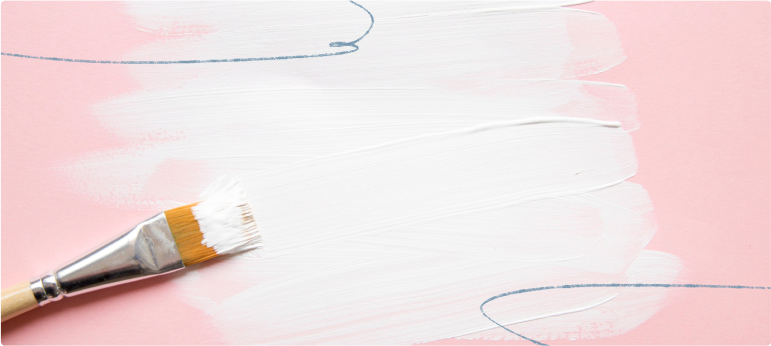
Oiler
Due to its name, some beginners might mistakenly think that a “paint pot” is a container for oil paint. In reality, it is a small container used to hold solvent for oil paints.
In the world of solvents, there is a variety of paint pots: single and double, metal and plastic, with and without lids.
Single: this type of paint pot contains only one jar. It is an ideal solution for plein air painting and for those who prefer to use only a specific solvent while working with oil paints.
Double: as the name suggests, a double paint pot consists of two jars connected together. They are often used for different types of solvents. For example, one jar can hold linseed oil, while the other holds pure solvent for quick cleaning of brushes.
Plastic: plastic paint pots are known for their affordable price, which inevitably attracts beginners. However, they are not always convenient to use: plastic paint pots are easily deformed and prone to impacts and drops. If you decide to purchase a plastic paint pot, make sure it is made from safe material.
Metal: this type of paint pot can confidently be classified as a professional tool! Its price is higher than that of plastic counterparts, but it lasts longer. The key factors here are the strength of the metal and the presence of a rubber gasket (if a lid is included). Thanks to this gasket, your paint pot will close tightly, preventing leaks and blocking the solvent’s odor.
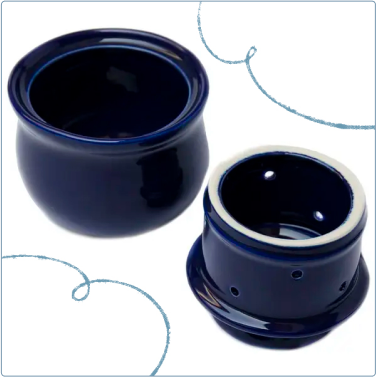

Easel
An easel is not just a wooden frame on legs designed to support a canvas. It is the most important space where an artist interacts with the world, brings their creative ideas to life, and creates works of art.
Many people think that easels take up too much space, so they hesitate to buy one. However, there is a wide variety of easels available on the market, many of which are easy to fold and store.
Additionally, having an easel with a painting can add a touch of charm and creative atmosphere to your home, subtly indicating to guests: “Here lives someone with a creative outlook on life.”
Which easel should you choose?

Traditional Tripod Easel: the most common type of easel. It has a tripod made of wood or metal, connected by a hinge at the top. These easels are usually suitable for studios or spacious rooms.

Landscape Easel: this type of easel is specifically designed for artists working outdoors. Its supports allow the artist to set it up on any uneven surface, such as on the ground or grass.

Mounted Easel: consists of a flat platform that can be attached to a wall or another surface. This design is ideal for artists with limited space.

Articulated Easel: this is a special type of easel with multiple joints and adjustable elements. It allows the artist to change the angle of the canvas and the height of the work, achieving the best position for comfortable and effective painting.

Multi-Functional Easel: a special type of easel that combines several functions. It has additional shelves for storing paints, brushes, and other materials, and may also include a small table for mixing paints or supporting additional tools.
As mentioned earlier, the size of easels is no longer a serious problem, and even in the smallest apartment, you can easily accommodate an easel to bring creative ideas to life.
When deciding on an easel for your home, the most important thing is to determine where it will be placed.
If you are just starting out in painting, do not buy very expensive or elaborate models; it is better to learn on something simple and understandable.
Palette knife
And the last essential tool in a painter’s arsenal is the palette knife. A palette knife consists of a small plastic or metal handle with a blade, into which a piece of paste is inserted. Paste is a soft mixture of pigments and oil.
This tool allows for applying paint in thin layers, which helps create softer and smoother color transitions, as well as adds interesting textural elements to the artwork.
If you are new to oil painting and are unsure which palette knives are suitable for beginners, I suggest starting with two basic types. The first choice could be a knife with a sharp tip and an elongated blade, while the second could be one with a beveled edge for working on fine details.
You might consider buying palette knives with a metal base, as they are usually of higher quality. Preference should be given to those made of stainless steel, which ensures a longer lifespan. To assess the quality, check the blade tip by applying pressure. If the steel does not bend and maintains its shape, this indicates a good choice.

Plastic alternatives are cheaper but tend to bend. However, this option is indeed suitable for those who want to try a new painting technique without spending too much.
If you choose a palette knife with a wooden handle, pay attention to how comfortably it fits in your hands, as working with it might take several hours.
It is important that the surface of the handle is smooth, without unevenness or snags. The blade should also have good springiness and easily return to its original position when bent. Ensure that the handle of the tool you choose is securely attached to the blade and does not wobble.
In fact, there are many alternatives to a palette knife: a roller, sponge, piece of wood, or a scrap of cardboard or plastic—artists use these as makeshift tools when a palette knife isn’t available.
Kits: what you need for oil painting
 Artistic Paints
Artistic Paints
The first step is choosing the right paints. Oil painting sets often include a range of colors, from basic primaries to exotic shades. Your paints can range from warm ochres and siennas to deep, mysterious blues and purples.
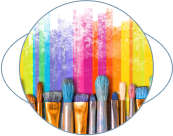 Brushes
Brushes
Brushes are the second crucial component. Various shapes and sizes allow for both broad, energetic strokes and delicate details. From flat brushes for backgrounds to tiny detail brushes—a set of brushes will be your faithful companion in exploring the oil painting palette.
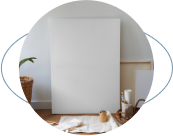 Canvas
Canvas
Choosing the right canvas is also important. Oil painting sets may include canvases of various sizes and shapes, giving you the freedom to bring your painting to life. From square formats to panoramic views—each canvas offers new opportunities for creativity.
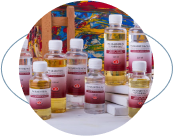
Thinners
Don’t forget about cleaning and thinning agents. Oil mediums not only keep your tools clean but also help create various textures and effects on the canvas.
 Palette
Palette
The palette is your laboratory where colors mix and unique shades are born.
 Canvas Stand
Canvas Stand
To ensure your creative process is as comfortable as possible, add a canvas stand to your artist’s kit. This allows you to adjust the canvas position and find the optimal angle for working. The painting process should be enjoyable and comfortable for you.
 Curiosity!
Curiosity!
In the end, the most important tools you can’t buy are your curiosity and inspiration. Develop your art, study the techniques of great artists, and don’t be afraid to experiment. Who knows what masterpieces might emerge from your strokes?
Conclusion
The heart of every artwork lies in the paints, with their variety of shades and richness. The brush, like the artist’s magical pen, embodies inspiration, allowing the creator to transfer their thoughts and feelings onto the canvas. The palette knife adds softness and texture, giving depth to the work.
I hope my article has been helpful to you, and now you know exactly which materials to add to your shopping list. I wish for your art supply receipt to be not too… long 😉



